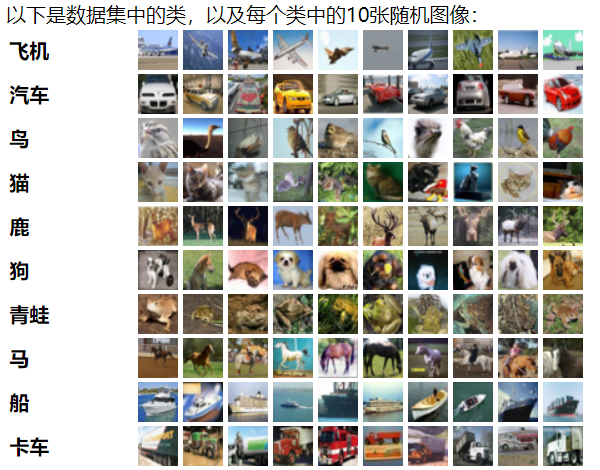利用卷积神经网络处理cifar图像分类
这是一个图像分类的比赛CIFAR( CIFAR-10 - Object Recognition in Images )
首先我们需要下载数据文件,地址:
http://www.cs.toronto.edu/~kriz/cifar.html
CIFAR-10数据集包含10个类别的60000个32x32彩色图像,每个类别6000个图像。有50000张训练图像和10000张测试图像。
数据集分为五个训练批次和一个测试批次,每个批次具有10000张图像。测试批次包含每个类别中恰好1000张随机选择的图像。训练批次按随机顺序包含其余图像,但是某些训练批次可能包含比另一类更多的图像。在它们之间,培训批次精确地包含每个班级的5000张图像。
这些类是完全互斥的。汽车和卡车之间没有重叠。“汽车”包括轿车,SUV和类似的东西。“卡车”仅包括大型卡车。都不包括皮卡车。

详细代码:
1.导包
import numpy as np # 序列化和反序列化
import pickle from sklearn.preprocessing import OneHotEncoder import warnings
warnings.filterwarnings('ignore') import tensorflow as tf
2.数据加载
def unpickle(file):
with open(file, 'rb') as fo:
dict = pickle.load(fo, encoding='ISO-8859-1')
return dict # def unpickle(file):
# import pickle
# with open(file, 'rb') as fo:
# dict = pickle.load(fo, encoding='bytes')
# return dict labels = []
X_train = []
for i in range(1,6):
data = unpickle('./cifar-10-batches-py/data_batch_%d'%(i))
labels.append(data['labels'])
X_train.append(data['data']) # 将list类型转换为ndarray
y_train = np.array(labels).reshape(-1)
X_train = np.array(X_train) # reshape
X_train = X_train.reshape(-1,3072) # 目标值概率
one_hot = OneHotEncoder()
y_train =one_hot.fit_transform(y_train.reshape(-1,1)).toarray()
display(X_train.shape,y_train.shape)
3.构建神经网络
X = tf.placeholder(dtype=tf.float32,shape = [None,3072])
y = tf.placeholder(dtype=tf.float32,shape = [None,10])
kp = tf.placeholder(dtype=tf.float32) def gen_v(shape):
return tf.Variable(tf.truncated_normal(shape = shape)) def conv(input_,filter_,b):
conv = tf.nn.relu(tf.nn.conv2d(input_,filter_,strides=[1,1,1,1],padding='SAME') + b)
return tf.nn.max_pool(conv,[1,3,3,1],[1,2,2,1],'SAME') def net_work(input_,kp): # 形状改变,4维
input_ = tf.reshape(input_,shape = [-1,32,32,3])
# 第一层
filter1 = gen_v(shape = [3,3,3,64])
b1 = gen_v(shape = [64])
conv1 = conv(input_,filter1,b1)
# 归一化
conv1 = tf.layers.batch_normalization(conv1,training=True) # 第二层
filter2 = gen_v([3,3,64,128])
b2 = gen_v(shape = [128])
conv2 = conv(conv1,filter2,b2)
conv2 = tf.layers.batch_normalization(conv2,training=True) # 第三层
filter3 = gen_v([3,3,128,256])
b3 = gen_v([256])
conv3 = conv(conv2,filter3,b3)
conv3 = tf.layers.batch_normalization(conv3,training=True) # 第一层全连接层
dense = tf.reshape(conv3,shape = [-1,4*4*256])
fc1_w = gen_v(shape = [4*4*256,1024])
fc1_b = gen_v([1024])
fc1 = tf.matmul(dense,fc1_w) + fc1_b
fc1 = tf.layers.batch_normalization(fc1,training=True)
fc1 = tf.nn.relu(fc1)
# fc1.shape = [-1,1024] # dropout
dp = tf.nn.dropout(fc1,keep_prob=kp) # 第二层全连接层
fc2_w = gen_v(shape = [1024,1024])
fc2_b = gen_v(shape = [1024])
fc2 = tf.nn.relu(tf.layers.batch_normalization(tf.matmul(dp,fc2_w) + fc2_b,training=True)) # 输出层
out_w = gen_v(shape = [1024,10])
out_b = gen_v(shape = [10])
out = tf.matmul(fc2,out_w) + out_b
return out
4.损失函数准确率
out = net_work(X,kp) loss = tf.reduce_mean(tf.nn.softmax_cross_entropy_with_logits_v2(labels=y,logits=out)) # 准确率
y_ = tf.nn.softmax(out) # equal 相当于 ==
accuracy = tf.reduce_mean(tf.cast(tf.equal(tf.argmax(y,axis = -1),tf.argmax(y_,axis = 1)),tf.float16))
accuracy
5.最优化
opt = tf.train.AdamOptimizer().minimize(loss)
opt
6.开启训练
epoches = 50000
saver = tf.train.Saver() index = 0
def next_batch(X,y):
global index
batch_X = X[index*128:(index+1)*128]
batch_y = y[index*128:(index+1)*128]
index+=1
if index == 390:
index = 0
return batch_X,batch_y test = unpickle('./cifar-10-batches-py/test_batch')
y_test = test['labels']
y_test = np.array(y_test)
X_test = test['data']
y_test = one_hot.transform(y_test.reshape(-1,1)).toarray()
y_test[:10] with tf.Session() as sess:
sess.run(tf.global_variables_initializer())
for i in range(epoches):
batch_X,batch_y = next_batch(X_train,y_train)
opt_,loss_ = sess.run([opt,loss],feed_dict = {X:batch_X,y:batch_y,kp:0.5})
print('----------------------------',loss_)
if i % 100 == 0:
score_test = sess.run(accuracy,feed_dict = {X:X_test,y:y_test,kp:1.0})
score_train = sess.run(accuracy,feed_dict = {X:batch_X,y:batch_y,kp:1.0})
print('iter count:%d。mini_batch loss:%0.4f。训练数据上的准确率:%0.4f。测试数据上准确率:%0.4f'%
(i+1,loss_,score_train,score_test))
这个准确率只达到了百分之80
如果想提高准确率,还需要进一步优化,调参
利用卷积神经网络处理cifar图像分类的更多相关文章
- TensorFlow系列专题(十四): 手把手带你搭建卷积神经网络实现冰山图像分类
目录: 冰山图片识别背景 数据介绍 数据预处理 模型搭建 结果分析 总结 一.冰山图片识别背景 这里我们要解决的任务是来自于Kaggle上的一道赛题(https://www.kaggle.com/c/ ...
- Neuromation新研究:利用卷积神经网络进行儿童骨龄评估
近日,Neuromation 团队在 Medium 上撰文介绍其最新研究成果:利用卷积神经网络(CNN)评估儿童骨龄,这一自动骨龄评估系统可以得到与放射科专家相似或更好的结果.该团队评估了手骨不同区域 ...
- 【翻译】TensorFlow卷积神经网络识别CIFAR 10Convolutional Neural Network (CNN)| CIFAR 10 TensorFlow
原网址:https://data-flair.training/blogs/cnn-tensorflow-cifar-10/ by DataFlair Team · Published May 21, ...
- 利用卷积神经网络(CNN)构造社区问答系统
/* 版权声明:能够随意转载,转载时请标明文章原始出处和作者信息 .*/ author: 张俊林 ...
- 利用卷积神经网络(VGG19)实现火灾分类(附tensorflow代码及训练集)
源码地址 https://github.com/stephen-v/tensorflow_vgg_classify 1. VGG介绍 1.1. VGG模型结构 1.2. VGG19架构 2. 用Ten ...
- Tensorflow学习教程------利用卷积神经网络对mnist数据集进行分类_利用训练好的模型进行分类
#coding:utf-8 import tensorflow as tf from PIL import Image,ImageFilter from tensorflow.examples.tut ...
- 利用卷积神经网络实现MNIST手写数据识别
代码: import torch import torch.nn as nn import torch.utils.data as Data import torchvision # 数据库模块 im ...
- SIGAI深度学习第八集 卷积神经网络2
讲授Lenet.Alexnet.VGGNet.GoogLeNet等经典的卷积神经网络.Inception模块.小尺度卷积核.1x1卷积核.使用反卷积实现卷积层可视化等. 大纲: LeNet网络 Ale ...
- 直白介绍卷积神经网络(CNN)【转】
英文地址:https://ujjwalkarn.me/2016/08/11/intuitive-explanation-convnets/ 中文译文:http://mp.weixin.qq.com/s ...
随机推荐
- Linux工具[转]
ref: https://github.com/linw7/Skill-Tree/blob/master/Linux%E5%B7%A5%E5%85%B7.md Linux工具 Linux下还是有很多超 ...
- LibreOJ #525. 「LibreOJ β Round #4」多项式
二次联通门 : LibreOJ #525. 「LibreOJ β Round #4」多项式 官方题解 : /* LibreOJ #525. 「LibreOJ β Round #4」多项式 由于会有多种 ...
- ShellExecute打开文件,打开文件夹的用法
转自https://www.cnblogs.com/nxopen2018/p/11070031.html //方法1 //转换 //char msg[256]; //sprintf_s(msg, &q ...
- 第02组 Alpha冲刺(2/6)
队名:無駄無駄 组长博客 作业博客 组员情况 张越洋 过去两天完成了哪些任务 任务分配.进度监督 提交记录(全组共用) 接下来的计划 沟通前后端成员,监督.提醒他们尽快完成各自的进度 还剩下哪些任务 ...
- [WC2010]重建计划(长链剖分版)
传送门 Description Solution 时隔多年,补上了这题的长链剖分写法 感觉比点分治要好写的多 我们假设\(pos\)是当前点的\(dfn\),它距离所在链的底端的边的数量是\(len\ ...
- 模板 - 数学 - 数论 - 扩展Euler定理
费马(Fermat)小定理 当 \(p\) 为质数,则 \(a^{p-1}\equiv 1 \mod p\) 反之,费马小定理的逆定理不成立,这样的数叫做伪质数,最小的伪质数是341. 欧拉(Eule ...
- 【转】JVM类装载机制的解析,热更新的探讨
引言 如有错误,请批评指正. Java是一种动态连接的语言.所谓动态连接,大概可以这么解释. 首先,Java可以大概想象成是编译解释执行的.对于一个*.java的文件,通过javac将会编译成一个*. ...
- office project visio 2019
office2019,2016,2013,2010 Visio.Project 各版本下载激活!点我! http://blog.sina.com.cn/s/blog_170abd40a0102yah2 ...
- nginx的代理配置
date: 2019-07-19 16:52:18 author: headsen chen proxy_pass http://aaa /; 如果在proxy_pass末尾的url加/,表示绝对 ...
- HDCMS多图字段的使用?
下面是HDCMS多图字段的简单使用: HDCMS在后台添加的多图,存到数据的时候是经过序列化过的,所以在使用的时候需要进行反序列化操作: $moreImg = M('keshi')->where ...
